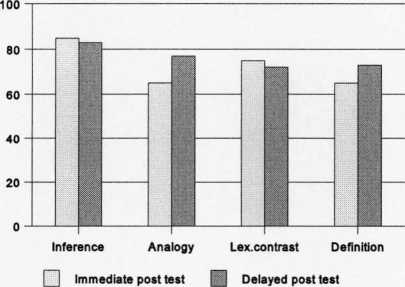Whether the same pattern was evident within each linguistic condition for both tests was also
investigated. The same pattern was found within each linguistic condition for each post test.
Significant differences were found for the Definition condition during the delayed post test
(Kruskal-Wallis, 1 Way ANOVA: X2= 6.3, df=2, p<.05 ). Post hoc analysis revealed that the
6 year-olds performed significantly better than the 4 year-olds in the immediate (Mann-
Whitney :Z=2.1, p<.05) and the delayed post tests (Mann-Whitney: Z=2.1, p<.05).
Furthermore, the 5 year-olds performed significantly better than the 4 year-olds in the delayed
post test (Mann-Whitney: Z-2.00, p<.05).
To what extent does children’s performance on the inference task differ by linguistic
condition?
If all children from each linguistic condition (48 participants) were correct on the two target
words, the maximum total score would be 96 for each linguistic condition and each post test.
Figure 5.9 below illustrates children’s performance on the inference task by linguistic
condition for both post tests. As the figure shows, during the immediate post test, children
in the Inference and Lexical contrast conditions performed better on the inference task than
children in the other conditions. During the Delayed post test children in the inference and
Analogy condition performed better than children in the other conditions.
Figure 5.9 Total number of correct responses in the inference task by linguistic
condition for both post tests

Two one way ANOVAs were carried out with score in the inference task as the dependent
variable and linguistic condition as the dependent factor. Significant differences were found
during the immediate post test (Kruskal-Wallis, 1 Way ANOVA: X2= 13.9, df=3, p<.005).
Post hoc analysis demonstrated that during the immediate post test, the children in the
129
More intriguing information
1. Innovation and business performance - a provisional multi-regional analysis2. Strategic monetary policy in a monetary union with non-atomistic wage setters
3. The name is absent
4. Who runs the IFIs?
5. Investment and Interest Rate Policy in the Open Economy
6. Why Managers Hold Shares of Their Firms: An Empirical Analysis
7. The Structure Performance Hypothesis and The Efficient Structure Performance Hypothesis-Revisited: The Case of Agribusiness Commodity and Food Products Truck Carriers in the South
8. Agricultural Policy as a Social Engineering Tool
9. Fiscal Reform and Monetary Union in West Africa
10. El impacto espacial de las economías de aglomeración y su efecto sobre la estructura urbana.El caso de la industria en Barcelona, 1986-1996